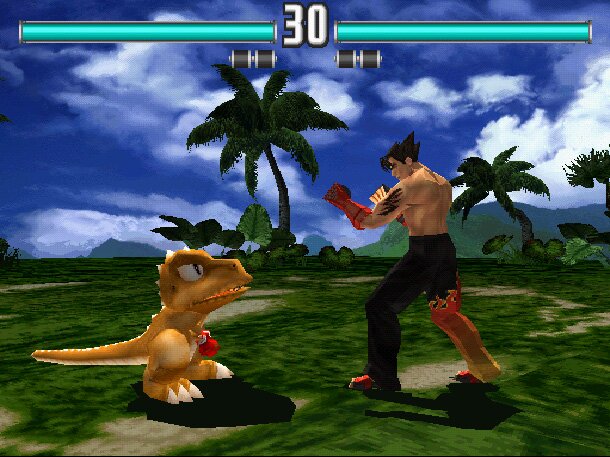
Following the successful release of the first two TEKKEN games, things were looking pretty good at Namco towards the end of the 1990′s. They’d struck gold with their approach to the fighting genre and the innovative ‘family feud’ storyline which governed TEKKEN’s central narrative. By 1997 they’d truly found their feet with this series and with new technology on their side, Namco proceeded to create one of the greatest fighting games in video game history…
TEKKEN 3
Released in 1998 to commercial and critical acclaim TEKKEN 3 was the fighting game people had been waiting for. With numerous 10/10 review scores and to this day holding the number 8 spot on GameRanking for best game of all time, it was a milestone of innovation that in many ways remains unsurpassed by any contemporary releases in the fighting genre.
As the final TEKKEN release for the first Playstation console, Namco certainly ensured it went out with a bang. The upgraded system (Namco System 12) dramatically improved graphics and gameplay, and audiences across the board were awed at the speed and realism with which the characters now moved on-screen. CGI cut scenes, music, and gameplay environments were all carefully designed and combined into TEKKEN 3 with greater depth and quality than had ever been seen before. The improvements were so extensive that even today it remains as playable as it was fifteen years ago, and argued by many to be the best of the TEKKEN games to date.

TEKKEN 3 took on a distinctly darker look and feel than previous games, maturing out of the sparsely detailed globe-trotting environments of TEKKEN 1 and 2 and opting for a generally more gritty urbanised setting, and a contemporary, fast-paced soundtrack.
Along with the modernised setting came a new breed of young fighters and fighting styles. Eddy Gordo, for example, opened an audience of millions up to the existence of Capoeira (a form of fighting based on break dancing, which really does exist), and once again illustrated TEKKEN’s ability to stay ahead of the curve, re-inventing itself for a new generation of gamer. Along with Eddy came Ling Xiaoyu, Julia Chang, Hwoarang, and most importantly, the new face of the franchise, Kazuya’s son, Jin Kazama.
IN THE SPOTLIGHT:
Jin Kazama:
With Kazuya presumed dead, the Mishima bloodline once again perpetuates a new generation for a new game. Jin debuted in TEKKEN 3 as the offspring of Kazuya Mishima and TEKKEN 2’s annoyingly wholesome Jun Kazama. The opposing temperaments of these parents give him a complexity to rival his fathers, and we later find that his dark-side also manifests itself as an aesthetically awesome Devil being. Unlike Kazuya however, Jin actively attempts to rid himself of the Devil Gene throughout the series and exhibits selfless traits that are lacking in both his father and grandfather, Heihachi.
Although, as of TEKKEN 6, the family feud storyline has developed to the point of ridiculous, Jin is still a complex and engaging character whose motives remain translucent at the best of times. If anyone’s going to salvage the main story-arc of the series, it would be reasonable to suggest it’s him.
Hwoarang:
Without a doubt Hwoarang is the alternative face for TEKKEN 3. Anyone frequenting Arcades in the late 1990s would have witnessed his Taekwondo patterns in the groundbreaking sequence that showcased everything that was awesome about this brand new fighting game.
Although lacking narrative depth (his role throughout the series is to be an angry young fighter who has recurring showdowns with Jin), Hwoarang nonetheless epitomises what TEKKEN 3 brought to the table. The speed and fluidity of his fighting style, the advanced stances and technicalities of his gameplay, and his aesthetically original appeal, combine to make him the rebellious anti-hero that would usher the series into the next generation.
Hwoarang is also eased into TEKKEN more convincingly than some characters, who just appear out of nowhere with some half-baked narrative. Appearing as a student of Taekwondo in Baek Doo San’s TEKKEN 2 ending, Hwoarang’s presence early on gave him a validity that makes him appealing to both newcomers and series veterans alike.
Finishing Touches:
TEKKEN 3 includes the game modes introduced in TEKKEN 2, but is chiefly renowned for debuting some new ones of its own. The infamous side-scrolling beat ‘em up TEKKEN Force Mode and the tongue-in-cheek mini-game TEKKEN Ball Mode are just another testament to how far the series had come, and the sense of humour it had developed, since 1994.
TEKKEN Force Mode proved especially popular with audiences by pitting a TEKKEN character against an onslaught of assorted foes in an old-school style beat ‘em up. The prize at the end was unlocking the shockingly useless Dr Boskonovich, but was a rewarding effort all the same.
TEKKEN Ball Mode was the first of many joke games that the series would become renowned for, and allowed the player to unlock the comic-relief character, and Japanese Manga star, Gon.
Along with Gon and Dr Boskonovich came the unlockable 70s disco dancer, Tiger Jackson. These characters weren’t just rewarding unlockables, but also helped counteract the increasingly serious story-arc concerning Jin, Heihachi and Ogre.
With TEKKEN 3, Namco created a successful balance between comic-relief and a more ‘serious’ form of fighting game without spilling too radically into either. As such, along with its groundbreaking improvements in almost every respect, TEKKEN 3 struck with a universal appeal that helped it outlast its rivals and many countless modern fighting games since.
Next time, you can’t win ‘em all, TEKKEN 4….


 September 18th, 2012
September 18th, 2012  Will Dawson
Will Dawson



 Posted in
Posted in  Tags:
Tags: 